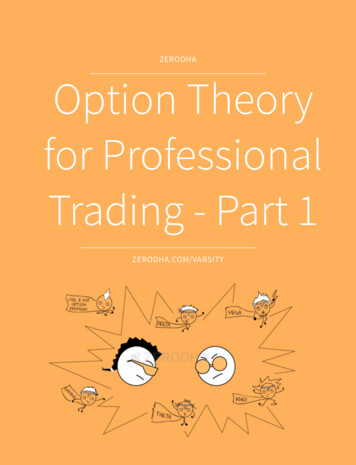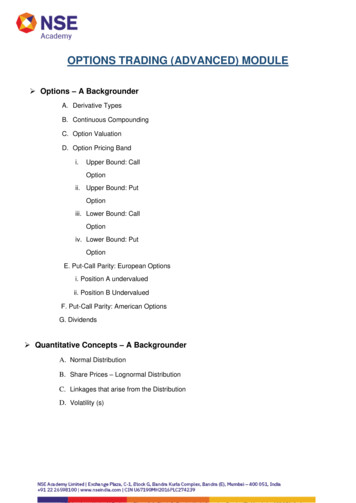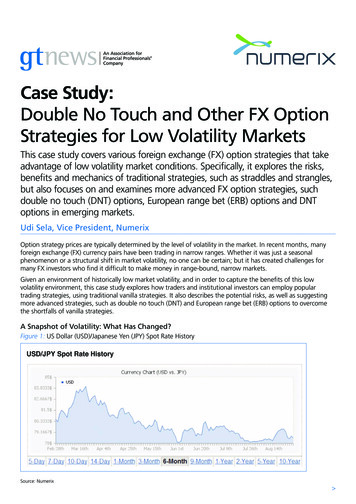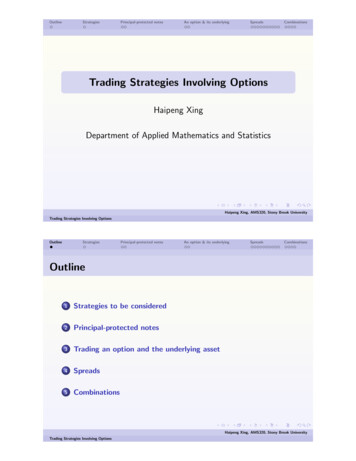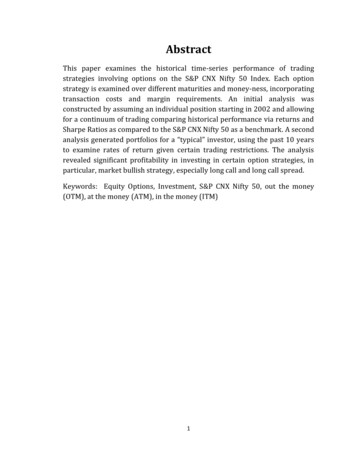
Transcription
AbstractThis paper examines the historical time-series performance of tradingstrategies involving options on the S&P CNX Nifty 50 Index. Each optionstrategy is examined over different maturities and money-ness, incorporatingtransaction costs and margin requirements. An initial analysis wasconstructed by assuming an individual position starting in 2002 and allowingfor a continuum of trading comparing historical performance via returns andSharpe Ratios as compared to the S&P CNX Nifty 50 as a benchmark. A secondanalysis generated portfolios for a “typical” investor, using the past 10 yearsto examine rates of return given certain trading restrictions. The analysisrevealed significant profitability in investing in certain option strategies, inparticular, market bullish strategy, especially long call and long call spread.Keywords: Equity Options, Investment, S&P CNX Nifty 50, out the money(OTM), at the money (ATM), in the money (ITM)1
Chapter 1Introduction1.1 BackgroundOption is a financial instrument which is extensively used in share markets, moneymarkets, and commodity markets to hedge the investment risks and acts as financialleverage investment. Option is a kind of derivative instruments along with forwards,futures and swaps, which are used for managing risk of the investors. Thoughderivatives are theoretically risk management tools and leveraged investment tools,most use them as speculative tools.Most research in the field of option involves the theoretical and empirical estimationof various option-pricing models and the role option play in hedging risk exposure.Although very little attention has been dedicated to the effect options have from anindividual investor standpoint. Explicitly, what effect investing in option strategieshave on portfolio returns? The purpose of this study is to examine, from anhistorical perspective, the return and risk to holding various option strategies froma representative investor standpoint.Our representative investor is considered different from an institutional investor,since the individual is constraint with limited net worth and faces the burden ofhigher transaction costs given bid-ask spreads, taxes and overall relative trade size.The results are formulated and designed to provide investment strategies acrossvarious level of risk aversion while maintaining a diversified portfolio. Hopefully,the results will provide new insight into investment options that can actually beutilized in today’s market.The underlying asset to which the portfolio will be compared to is the Standard andPoor’s CNX Nifty (Nifty 50), which is a capitalization –weighted index of 50 BlueChip stocks. The S&P CNX Nifty 50 is typically used as the benchmark for the overallperformance of the market. From a theoretical point of view, investing directly intothe index would eliminate all non-systematic risk. In general, most managers whoare active in the market accept beating the market as a measure of positiveabnormal returns. As such, utilizing options on the index to examine various optionstrategies, will allow the comparison relative to this benchmark for a wide array ofinvestor risk preferences.This research further focuses on three types of individual investors: high-riskaversion, medium-risk aversion, and low-risk aversion, where the medium riskaverse investor would accept the return and risk associated with the market. Eachstrategy is compared and generated with the idea of classifying the strategy within a2
risk aversion class. It does not examine the reasons an investor falls into eachcategory, but the results should provide useful alternatives for each of the threetypes of investors.When discussing risk, it should be clear that this research is not trying to define risknor is it trying to discover riskless investments. The S&P CNX Nifty 50 Index’s levelof risk will be the baseline for the medium risk-averse investor. The highly riskaverse investor will have a low risk tolerance based primarily on lower standarddeviation of returns. Similarly, the low risk averse investor will have a higher risktolerance, which allows for high volatility in returns. Rates of return and Sharperatios will be used in evaluating the strategies but only after classify the strategy toan investor type based on the volatility of that strategy.The options market today in India is liquid, low-transaction-cost, and penetrablemarket. An individual investor, today, can easily trade small quantities of contractsthrough a broker or an individual on-line brokerage account. The options markettoday is nothing like it was ten years ago. Ten years ago the options market barelyexisted and was primarily an institutional investment vehicle; the options markethad just become standardized, allowing an individual investor to invest in indexoptions but at extremely high costs and without out the fluidity of today’s market.In today’s market, option prices instantly change in value as prices fluctuate inunderlying assets, according to market maker’s valuation estimates. The ease ofentry and exit is as fluid as trading exchange listed stocks. Gains and losses can beeasily magnified by the leverage options provide, and through the research, asolution to maximize gains and realize the potential risk of losses will be highlightedfor each investor.1.2Rationale For The StudyThe market price reduction of the share is called as downside risk of the investor.The profit from the increase in the share price is known as upside potential. Optionstrategies help the investors to cap the downside risk at the same time keep theupside potential unlimited. This is the most desired need of the investors. Buying acall option and selling a put option works well in the bull market, limiting the loss tothe premium paid but the upside potential in unlimited as market price increases.Similarly, in a bearish situation, selling a call and buying a put are the strategies ofcapping the downside risk. Apart from the above plain vanilla strategies, bull –spread, bear – spread, calendar spreads, butterfly spreads, diagonal spreads,straddle, strangle, strips, and straps are some of the famous strategies to cap thedownside risks up to any level required by the investors. This property makes theoption a unique tool for risk management and a preferred one.3
Option strategies can be used by the investors to bring down their risk from thefluctuations in the market and can also use it to generate a significant return from it.For example Bakshi and Kapadia (2003) and Coval and Shumway (2001) show thatselling puts and selling straddles on the S&P 500 offer unusually high returns fortheir level of risk. For instance, Coval and Shumway show that shorting an at-themoney, near-maturity straddle offered a return of 3.15 percent per week in theirsample. Although very little attention has been dedicated to the effect options havefrom an individual investor standpoint. Explicitly, what effect investing in optionstrategies have on portfolio returns? Some studies have been done in moredeveloped markets like U.S.A (United State of America) but there are no such studiesin Indian context as option market is still in its early stage. This study will try tobridge this gap and will provide the answers to this question.1.3ObjectivesThe key objectives of the thesis are as follows:a) To find effect of writing or holding options have on individual’s portfolioreturnsb) To distinguish the option trading strategies on the basis of investors riskappetitec) To find out strategy that generates a significant return in Indian stockexchange marketThe results will provide new insight into investment options that can actually beutilized in today’s market.1.4DataThe sample used for construction of portfolio consists of Index Options trading onNSE which satisfy following conditions:a) The options are European Options.b) The period of analysis span from January 2002 until March 2012.c) The option price used is the average of daily opening, mid and closing priceof the option.d) The risk-free rates are obtained from the Reserve Bank of India.e) The maturity period of options is 3-months but the position in strategies isnot established until 45, 37 and 30 days before the expiry so option pricesare taken accordingly. The positions are taken only on Thursday and ifThursday is holiday then positions are taken prior to it.4
f) Each of the strategies was evaluated over three levels of money-ness; Out-ofthe money (OTM), at-the money (ATM), and in-the money (ITM). Thestrategies are all based on leveraging and investing in the S&P CNX Nifty 50Index.The data were obtained from Bloomberg Data Base (Courtesy: Navam Capital)1.5Limitation of the StudyThe study is limited to National Stock Exchange and limited to index options, whichare traded from January 2002 till March 2012 for some strategies and for somestrategies period of analysis span from October 2007 till March 2012 due tounavailability of data, as the trades in BSE has been less than one percentagecompare to NSE trade.1.6 Organization of the StudyChapter 2 briefly reviews the literature related to testing methodologies used inpast empirical studies on equity option strategies for an individual investor.Chapter 3 contains a detailed description of methodology used in the analysis andits relevance. This is followed by the results of the study.Chapter 4 contains the discussion of results.Chapter 5 contains a brief summary and conclusions of the study.5
Chapter 2Literature ReviewThis section contains two subsections. The first subsection discusses the theoreticaldetails whereas the second subsection most commonly used methodology used fortesting equity option strategies for individual investors and the empirical findingsfrom a number of studies related to the markets all around the world.2.1 Option OverviewOption is a financial instrument whose value depends upon the value of theunderlying assets. Option itself has no value without underlying assets. Option givesthe right to the buyer either to sell or to buy the specified underlying assets for aparticular price (Exercise / Strike price) on or before a particular date (expirationdate). If the right is to buy, it is known as “call option” and if the right is to sell, it iscalled as “put option”. The buyer of the option has the right but no obligation eitherto buy or to sell. The option buyer has to exercise the option on or before theexpiration date, otherwise, the option expires automatically at the end of theexpiration date. Hence, options are also known as contingent claims.Such an instrument is extensively used in share markets, money markets, andcommodity markets to hedge the investment risks and acts as financial leverageinvestment. Option is a kind of derivative instruments along with forwards, futuresand swaps, which are used for managing risk of the investors. Though derivativesare theoretically risk management tools and leveraged investment tools, most usethem as speculative tools.Though the derivatives were very old as early as 1630s, the exchange tradedderivative market was introduced during 1970s. 1973 marked the creation of boththe Chicago Board Options Exchange and the publication of the most famousformula in finance, the option-pricing model of Fischer Black and Myron Scholes.These events revolutionized the investment world in ways no one could imagine atthat time. The Black-Scholes model, as it came to be known, set up a mathematicalframework that formed the basis for an explosive revolution in the use ofderivatives. Chicago Board Options Exchange (CBOE) was founded as first UnitedStates of America (USA) options exchange and trading begins on standardized, listedoptions. April 26, the first day of trading sees 911 contracts traded on 16 underlyingstocks. During 1975, computerized price reporting was introduced and Options6
Clearing Corporation was formed. The Black-Scholes model was adopted for pricingoptions in CBOE. In the year 2005, CBOE’s options contract volume was an all-timerecord of 468,249,301 contracts (up 30% over the previous year), and the notionalvalue of this volume was more than US 1.2 trillion.In 1983, the Chicago Board Options Exchange decided to create an option on anindex of stocks. Though originally known as the CBOE 100 Index, it was soon turnedover to Standard and Poor's and became known as the S&P 100, which remains themost actively traded exchange-listed option.Options have the most peculiar property of capping the downside risk at the sametime keeping the unlimited upside potential. Furthermore, the importance of theoption trading and the requirement of its correct pricing are far more critical anduseful in decision making, which are narrated below.First, prices in an organized derivatives market reflect the perception of marketparticipants about the future and lead the prices of underlying to the perceivedfuture level. The prices of derivatives converge with the prices of the underlying atthe expiration of the derivative contract. Thus derivatives help in discovery of futureas well as current prices. Second, the derivatives market helps to transfer risks fromthose who have them but may not like them to those who have an appetite for them.Third, derivatives, due to their inherent nature, are linked to the underlying cashmarkets. With the introduction of derivatives, the underlying market witness highertrading volumes, because more players participated who would not otherwiseparticipate for lack of an arrangement to transfer risk. Fourth, the speculative tradesshift to a more controlled environment of derivatives market. In the absence of anorganized derivatives market, speculators trade in the underlying cash markets.Margining, monitoring and surveillance of the activities of various participantsbecome extremely difficult in these kinds of mixed markets. Fifth, an importantincidental benefit that flows from derivatives trading is that it acts as a catalyst fornew entrepreneurial activity. The derivatives have a history of attracting manybright, creative, well-educated people with an entrepreneurial attitude. They oftenenergize others to create new businesses, new products and new employmentopportunities, the benefit of which are immense. Finally, derivatives markets helpincrease savings and investment in the long run. Transfer of risk enables marketparticipants to expand their volume of activity.In India, derivatives trading was introduced Index Futures Contracts from June2000 and stock option trading in July 2001 grown very fast to reach an average dailyturnover of derivatives at NSE, at Rs.33,745 crores during May 2006 as against cashmarkets turnover of about Rs.9202.15 crores (as on May 2006), which indicates the7
importance of the derivatives. Normally, the derivative turnover is three to fourtimes the cash market turnover in India.Option, being one of the derivatives is a unique type of hedging tool. Black – Scholesformula after mesmerize the western countries also entered into in Indian optionmarket.2.1.1 Option Pricing:The price of the option is determined by many methods like binomial method, BlackScholes option pricing formula, Volatility jump model etc. out of which the BlackScholes option pricing model is most popular and widely used throughout theworld.The variables and the parameters that determine the call option price arediagrammatically given in Figure 1.1.Future is uncertain and must be expressed in terms of probability distributions. Theprobability distribution of the price at any particular future time is not dependenton the particular path followed by the price in the past. This states that the presentprice of a stock impounds all the information contained in a record of past prices. Ifthe weak form of market efficiency were not true, technical analysts could make8
above-average returns by interpreting charts of the past history of stock prices.There is very little evidence that they are in fact able to get above-average returns.It is competition in the marketplace that tends to ensure that weak-form marketefficiency holds. There are many, many investors watching the stock market closely.Trying to make a profit from it, leads to a situation where a stock price, at any giventime, reflects the information in past prices. Assume that it was discovered aparticular pattern in stock prices, which always gave a 65% chance of subsequentsteep price rises. Investors would attempt to buy a stock as soon as the pattern wasobserved, and demand for the stock would immediately rise. This would lead to animmediate rise in its price and the observed effect would be eliminated, as wouldany profitable trading opportunities.2.1.2 Option and the Stock MarketThe derivatives make the stock market more efficient. The spot, future and optionmarkets are inextricably linked. Since it is easier and cheaper to trade in derivatives,it is possible to exploit arbitrage opportunities quickly, and keep the prices inalignment. Hence these markets help ensure that prices of the underlying assetreflect true values.Options can be used in a variety of ways to profit from a rise or fall in the underlyingasset market. The most basic strategies employ put and call options as a low capitalmeans of garnering a profit on market movements, known as leveraging. Optionroute enable one to control the shares of a specific company without tying up a largeamount of capital in the trading account. A small portion of money say, 20%(margin) is sufficient to get the underlying asset worth 100 percentages. Optionscan also be used as insurance policies in a wide variety of trading scenarios. One,probably, has insurance on his / her car or house because it is the responsible actand safe thing to do. Options provide the same kind of safety net for trades andinvestments already committed, which is known as hedging.Options can provide leverage. This means an option buyer can pay a relatively smallpremium for market exposure in relation to the contract value (usually 100 sharesof underlying stock). An investor can see large percentage gains from comparativelysmall, favorable percentage moves in the underlying index. Leverage also hasdownside implications. If the underlying stock price does not rise or fall asanticipated during the lifetime of the option, leverage can magnify the investment’spercentage loss. Options offer their owners a predetermined, set risk. However, ifthe owner’s options expire with no value, this loss can be the entire amount of thepremium paid for the option. An uncovered option writer, on the other hand, mayface unlimited risk.9
The amazing versatility that an option offers in today's highly volatile markets iswelcome relief from the uncertainties of traditional investing practices. Options canbe used to offer protection from a decline in the market price of available underlyingstocks or an increase in the market price of uncovered underlying stock. Options canenable the investor to buy a stock at a lower price, sell a stock at a higher price, orcreate additional income against a long or short stock position. One can also usesoption strategies to profit from a movement in the price of the underlying assetregardless of market direction.There are three general market directions: market up, market down, and marketsideways. It is important to assess potential market movement when you are placinga trade. If the market is going up, you can buy calls, sell puts or buy stocks. Does onehave any other available choices? Yes, one can combine long and short options andunderlying assets in a wide variety of strategies. These are some of the strategiesthat limit your risk while taking advantage of market movement.Table 2.1Bullish Limited RiskStrategiesBullish Unlimited RiskStrategiesBearish Limited RiskStrategiesBuy CallBull Call SpreadBull Put SpreadBuy StockSell PutCovered CallBuy PutBear Put SpreadBear Call SpreadTable 2.2Neutral Limited Risk StrategiesLong StraddleLong StrangleLong ButterflyLong CondorBearishUnlimitedRiskStrategiesSell StockSell CallCovered PutNeutral Unlimited Risk StrategiesShort StraddleShort Strangle2.1.3 Option Strategies(An overview on “Strategies to be tested”)1.LONG CALLIf upon expiration, the spot price exceeds the strike price, he makes a profit. Higher the spotprice more is the profit he makes. If the spot price of the underlying is less than the strikeprice, he lets his option expire un-exercised. His loss in this case is the premium he paid forbuying the option. Market Expectation: Market Bullish/Volatility Bullish10
Volatility: The option value will increase as volatility increases (good) and will fall asvolatility falls (bad).Time Decay: As each day passes the value of the option erodes.2.SHORT CALLA call option gives the buyer the right to buy the underlying asset at the strike pricespecified in the option. For selling the option, the writer of the option charges a premium.The profit/loss that the buyer makes on the option depends on the spot price of theunderlying. Whatever is the buyer's profit is the seller's loss. If upon expiration, the spotprice exceeds the strike price, the buyer will exercise the option on the writer. Hence as thespot price increases the writer of the option starts making losses. Higher the spot pricemore is the loss he makes. If upon expiration the spot price of the underlying is less than thestrike price, the buyer lets his option expire un-exercised and the writer gets to keep thepremium.Market Expectation: Market Bearish/ Volatility BearishVolatility: The option value will increase as volatility increases (bad) and will decrease asvolatility decreases (good).Time Decay: As each day passes the value of the option erodes (good).11
3.LONG PUTA put option gives the buyer the right to sell the underlying asset at the strike pricespecified in the option. The profit/loss that the buyer makes on the option depends on thespot price of the underlying. If upon expiration, the spot price is below the strike price, hemakes a profit. Lower the spot price more is the profit he makes. If the spot price of theunderlying is higher than the strike price, he lets his option expire un-exercised. His loss inthis case is the premium he paid for buying the option.Market Expectation: Market Bearish/Volatility BullishVolatility: The option value will increase as volatility increases (good) and will fall asvolatility falls (bad).Time Decay: As each day passes the value of the option erodes (bad).4.SHORT PUTA put option gives the buyer the right to sell the underlying asset at the strike pricespecified in the option. For selling the option, the writer of the option charges a premium.The profit/loss that the buyer makes on the option depends on the spot price of theunderlying. Whatever is the buyer's profit is the seller's loss. If upon expiration, the spotprice happens to be below the strike price, the buyer will exercise the option on the writer.If upon expiration the spot price of the underlying is more than the strike price, the buyerlets his option un-exercised and the writer gets to keep the premium.Market Expectation: Market Bullish/Volatility BearishVolatility: The option value will increase as volatility increases (bad) and will decrease asvolatility decreases (good).Time Decay: As each day passes the value of the option erodes (good).12
5.LONG STRADDLEA Straddle is a volatility strategy and is used when the stock price / index is expected toshow large movements. This strategy involves buying a call as well as put on the same stock/ index for the same maturity and strike price, to take advantage of a movement in eitherdirection, a soaring or plummeting value of the stock / index. If the price of the stock / indexincreases, the call is exercised while the put expires worthless and if the price of the stock /index decreases, the put is exercised, the call expires worthless. Either way if the stock /index show volatility to cover the cost of the trade, profits are to be made. With Straddles,the investor is direction neutral. All that he is looking out for is the stock / index to breakout exponentially in either direction.Market Expectation: Market neutral/Volatility bullishVolatility: The option value will increase as volatility increases which is good for bothoptions. Alternatively a decrease in volatility will be bad for both options.Time Decay: As each day passes the value of the option erodes (bad).6.SHORT STRADDLEA Short Straddle is the opposite of Long Straddle. It is a strategy to be adopted when theinvestor feels the market will not show much movement. He sells a Call and a Put on thesame stock / index for the same maturity and strike price. It creates a net income for theinvestor. If the stock / index do not move much in either direction, the investor retains thePremium as neither the Call nor the Put will be exercised. However, in case the stock / indexmoves in either direction, up or down significantly, the investor’s losses can be significant.So this is a risky strategy and should be carefully adopted and only when the expectedvolatility in the market is limited. If the stock / index value stays close to the strike price onexpiry of the contracts, maximum gain, which is the Premium received is made.Market Expectation: Market neutral/Volatility bearish13
Volatility: The option value will decrease as volatility decreases which is good for bothoptions. Alternatively an increase in volatility will be bad for both options.Time Decay: As each day passes the value of the option erodes (good).7.LONG STRANGLEA Strangle is a slight modification to the Straddle to make it cheaper to execute. Thisstrategy involves the simultaneous buying of a slightly out-of-the-money (OTM) put and aslightly out-of-the-money (OTM) call of the same underlying stock / index and expirationdate. Here again the investor is directional neutral but is looking for an increased volatilityin the stock / index and the prices moving significantly in either direction. Since OTMoptions are purchased for both Calls and Puts it makes the cost of executing a Stranglecheaper as compared to a Straddle, where generally ATM strikes are purchased. Since theinitial cost of a Strangle is cheaper than a Straddle, the returns could potentially be higher.However, for a Strangle to make money it would require greater movement on the upside ordownside for the stock / index than it would for a Straddle. As with a Straddle, the strategyhas a limited downside (i.e. the Call and the Put premium) and unlimited upside potential.Market Expectation: Market neutral/volatility bullishVolatility: The option value will increase as volatility increases which is good for bothoptions. Alternatively a decrease in volatility will be bad for both options.Time Decay: As each day passes the value of the option erodes (bad).8.SHORT STRANGLEA Short Strangle is a slight modification to the Short Straddle. It tries to improve theprofitability of the trade for the Seller of the options by widening the breakeven points sothat there is a much greater movement required in the underlying stock / index, for the Calland Put option to be worth exercising. This strategy involves the simultaneous selling of aslightly out-of-the-money (OTM) put and a slightly out-of-the-money (OTM) call of the sameunderlying stock and expiration date. This typically means that since OTM call and put aresold, the net credit received by the seller is less as compared to a Short Straddle, but thebreak even points are also widened. The underlying stock has to move significantly for theCall and the Put to be worth exercising. If the underlying stock does not show much of amovement, the seller of the Strangle gets to keep the Premium.Market Expectation: Market neutral/volatility bearishVolatility: The option value will decrease as volatility decreases which is good for bothoptions. Alternatively an increase in volatility will be bad for both options.Time Decay: As each day passes the value of the option erodes (good).9.BULL CALL SPREAD STRATEGY: BUY CALL OPTION, SELL CALL OPTIONA bull call spread is constructed by buying an in-the-money (ITM) call option, and sellinganother out-of-the-money (OTM) call option. Often the call with the lower strike price will14
be in-the-money while the Call with the higher strike price is out-of-the-money. Both callsmust have the same underlying security and expiration month. The net effect of the strategyis to bring down the cost and breakeven on a Buy Call (Long Call) Strategy. This strategy isexercised when investor is moderately bullish to bullish, because the investor will make aprofit only when the stock price / index rise. If the stock price falls to the lower (bought)strike, the investor makes the maximum loss (cost of the trade) and if the stock price risesto the higher (sold) strike, the investor makes the maximum profit.Market Expectation: Market Bullish/Volatility NeutralVolatility: You are not affected by volatility.Time Decay: It depends on the underlying share price, if it is below A, then time decayworks against you. If it is above B, then it works for you.10.BULL PUT SPREAD STRATEGY: SELL PUT OPTION, BUY PUT OPTIONA bull put spread can be profitable when the stock / index is either range bound or rising.The concept is to protect the downside of a Put sold by buying a lower strike Put, which actsas insurance for the Put sold. The lower strike Put purchased is further OTM than the higherstrike Put sold ensuring that the investor receives a net credit, because the Put purchased(further OTM) is cheaper than the Put sold. This strategy is equivalent to the Bull CallSpread but is done to earn a net credit (premium) and collect an income. If the stock / indexrise, both Puts expire worthless and the investor can retain the Premium. If the stock /index falls, then the investor are breakeven is the higher strike less the net credit received.Provided the stock remains above that leve
testing equity option strategies for individual investors and the empirical findings from a number of studies related to the markets all around the world. 2.1 Option Overview Option is a financial instrument whose value depends upon the value of the underlying assets. Optio
